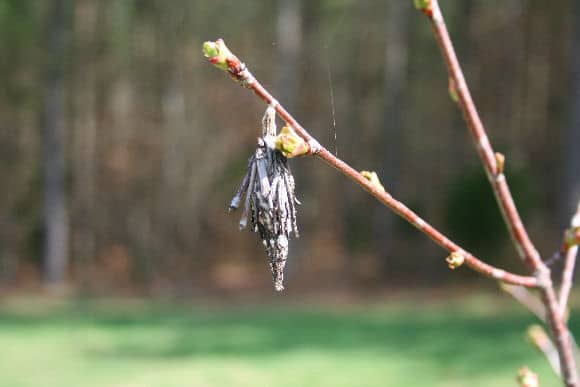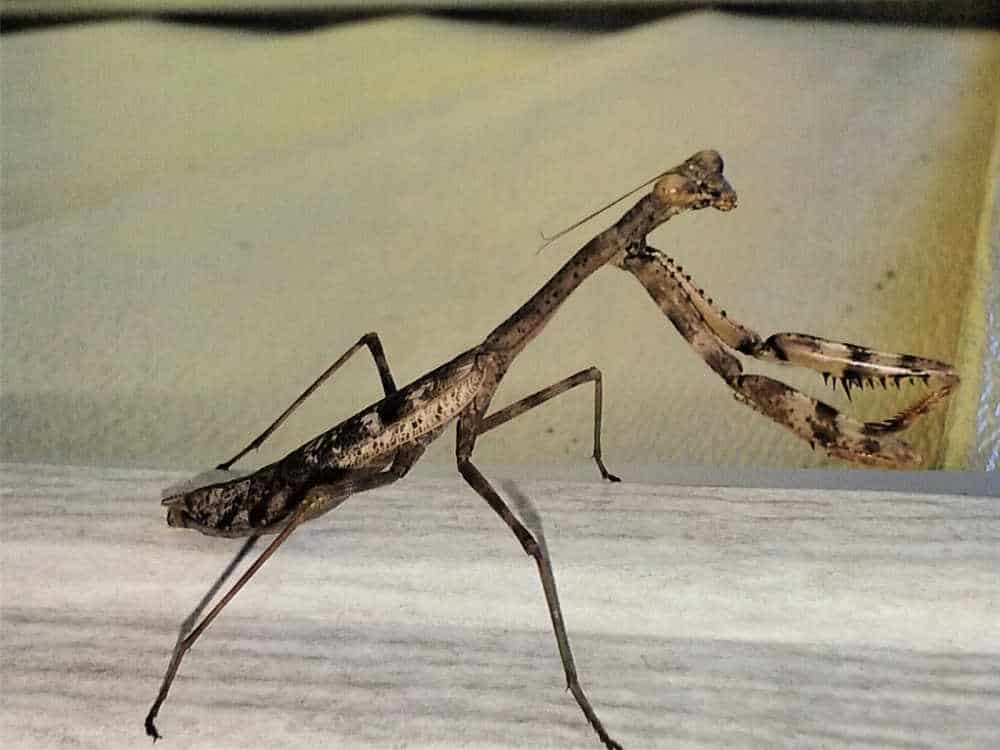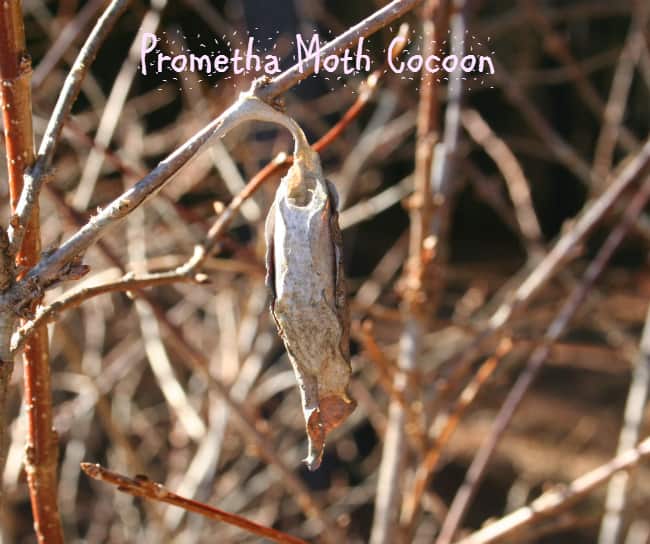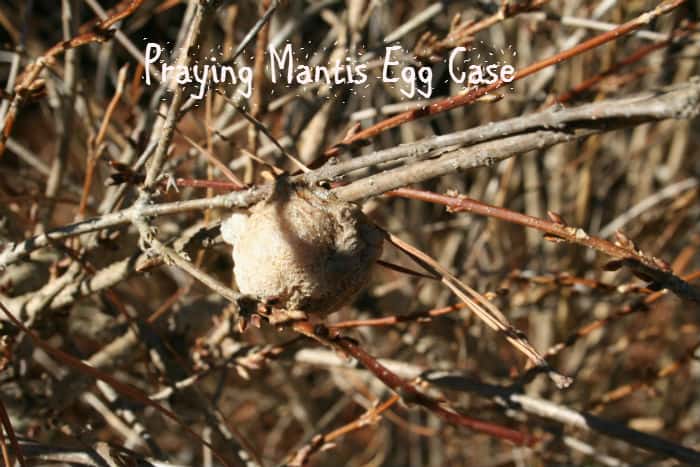Identifying good bugs from bad by their cocoons takes some practice. Here are the steps for insect identification that I use if I find a cocoon or egg case I don’t know.
Identifying Cocoons in the Garden
On Sunday as I was working in the garden, I noticed a few cocoons on the forsythia bushes by the driveway. One was familiar, but one was not. My husband asked, “Is it a bad bug? Or a good bug?”
A quick internet search later revealed it to be the cocoon of a familiar garden moth, a harmless creature who probably pollinated a few flowers each year and added color and liveliness to the garden. It would have been a shame to harm the cocoon; but many gardeners, unaware that some good bugs spin cocoons too, might have destroyed
The Difference Between a Cocoon and an Egg Case
Technically, moths spin cocoons and praying mantis spin egg cases, but for the sake of the average backyard gardener just looking at egg sacs hanging from trees in the garden and wondering if they should kill them or leave them alone, I’m sticking with “identifying good bugs from bad by their cocoons” for this article.
A Good Bug = Helpful to the Garden
There’s really no such thing as a good bug or a bad bug. Most people consider ‘good bugs’ those that are helpful to the garden or at least won’t hurt anything. ‘Bad bugs’ are those that harm plants, clothing (if indoors), or pose other threats.
Steps: Identifying Good Bugs from Bad by Their Cocoons
Step One: Take a photo of the cocoon.
Take a good, clear photo of the cocoon, like this one.

Step Two: Use Google Image Search
Upload the photo to Google Image Search. Google Image Search matches pictures based on general characteristics. It may bring up an exact match or you may need to hunt a bit more.
You may also want to look through Pinterest or similar sites to compare your pictures to those others have identified. The best photographic resources are those from your state’s Cooperative Extension office, but there are also universities and similar research institutions that publish pictures of insects to aid correct identification.
Step Three: Read exact or close matches
Go through the Google Images and click on close or exact matches. Read the articles with the pictures. Make sure that the cocoon and bug or insect identification information matches three things:
- The place where you live – by country, region, gardening zone. Insects aren’t universal. Bugs that I find here in Virginia may be different from those in Texas, Oklahoma, London, Baton Rouge, Dublin, Hamburg, or Moscow. The closer the match the better.
- Where you found the cocoon – did you find it inside your house or outside on a bush? What kind of bush or plant did you find it on? Insects lay their eggs near food sources. Like people, they want a good life for their babies and young, and so they place their egg cases and cocoons on plants that provide their babies with food when they hatch. That food is the plant or substance on which you find the egg case.
- What time of year is it? – some bugs lay eggs in summer, and others in the fall to hatch in the spring. Identifying good bugs from bad by their cocoon is easier when you can also match the time of year when you find the cocoon to the species of insect under consideration.
Step Four: Get professional help
I’m a Virginia master gardener, which means I’ve studied and earned a certificate from Virginia Tech on home gardening in the state of Virginia. But I am not an entomologist – a scientist who studies insects.
If you are really stumped and can’t figure out what kind of bug cocoon or egg case you are looking at, you have a few options.
- Find a good insect identification book for your region, country or zone and use that to figure out whose cocoon or egg case you are studying.
- Share a picture of the cocoon with garden center personnel or in the United States, your local Cooperative Extension office, for identification.
- Call in an exterminator for insect problems in your home. If you found the cocoon outside, the garden center person or Cooperative Extension Agent (see above) is a better person to talk to about your insect cocoon.
Three Examples: Identifying Good Bugs from Bad by Their Cocoon
I identified these three examples using the steps above. In each case, I was able to get help to identify the cocoon and insect species and determine whether I should leave it alone or remove it.
Example 1: Bagworm Moth (Bad/Harmful)
Cocoons can be difficult to spot in the garden – and that’s a good thing! Butterflies, moths and other insects shelter their egg cases and developing eggs in camouflage to ensure the survival of their young. The cocoons themselves are usually spun in colors similar to the foliage upon which they rest to better hide them from the curious gaze of hungry wintertime birds eager for a meal.
Take this cocoon, for example. It is a BAD bug – or at least bad from my perspective. This is the cocoon of the bagworm caterpillar. I found it a few years ago hanging on the boughs of my apricot tree in our fruit tree orchard.
The bagworm feeds upon the leaves of the host tree, sometimes stripping it bare. In the case of my young apricot trees, such damage could have been catastrophic. I had to remove the bagworms from the fruit trees and destroy them by hand. Correct identification of this pest’s bag or egg sac, which also looks like a cocoon, prevented the destruction of my fruit trees.
Example 2: Prometha Moth (Good/Neutral Bug)
Now take this adorable creature – the Prometha Moth.
We found several cocoons like the one above hanging on our forsythia hedge. My husband loves the forsythia hedge and tends it very carefully. He spotted the cocoons and immediately called me out to look at it, perhaps remembering the bagworm moth cocoon we had discovered in the orchard back in 2013. “What do you think?” he asked me.
“Leave it alone until I can figure out what it is,” I replied.
I quickly used an image search to find similar pictures and voila – cocoon identified! The Prometha Moth is a gentle creature that does eat host plant leaves but doesn’t really harm a plant the way others do. The host plants for hungry larvae include spicebush, sassafras, tulip tree, and lilac, among others. Given the number of cocoons we found on the forsythia, I’d say they like that plant, too.
We left them alone. I can’t wait to check on them in the spring. I hope to capture one emerging from its cocoon, if I can, and photograph it!
Example 3: Praying Mantis (Good Bug)
Last but not least is something that you’ve probably stumbled across in the garden. I hope you left it alone, as it is the egg case of the wonderful, slightly creepy looking praying mantis.
The praying mantis is a so-called “good” but because it preys on others. It literally pounces on insects and eats them. They dine on moths, crickets, grasshoppers, flies, and similar insects. Frankly, they can eat all the flies they want. Bon appetit!

The praying mantis can turn his head 180 degrees around, peering this way and that to find prey. He holds very still but can move rapidly. The green and brown coloring on his body camouflages him perfectly.
Each egg sac holds hundreds of babies, and when they emerge, they look like tiny adults. I’ve seen our butterfly bushes covered with the nymphs or newly hatched praying mantids. They are a marvel of nature, and gardeners usually welcome them. In fact, many garden supply catalogs and organic gardening supply catalogs sell egg cases because they are so beneficial to the garden!
How to Tell Good Bugs from Bad Bugs by Their Cocoons
Whenever you encounter a bug in the garden, the first rule is simple: leave it alone. Until you can identify the insect and determine whether or not it causes harm, it’s best to assume that it is either neutral or beneficial, that is, that it does not harm or may even provide an important benefit.
Cocoons, chrysalis and egg cases are no different. When you find one in the garden, leave it alone. Take a photograph of it. Talk to someone knowledgeable at your local nursery and garden center, Cooperative Extension Office, or a Master Gardener. Alternatively, you can upload your photo to a search engine like Google Image Search. It compares your picture to others online and will pull up similar pictures. Each one should link to a web page, and that will bring you to information on that particular egg case or cocoon. That’s how I identify many insects in the garden since I am not particularly good at understanding all the nuances of their wings and bodies in order to search scientifically. For me, searching by picture is the easiest method.
I hope that you’ve enjoyed this encounter with some of the insects in my garden. It’s amazing what you find, even in the middle of winter, if you look carefully enough around the garden.
This post updated 12/26/22 with additional photos








I have a cocoon hanging on the header of my front door outside, it is brown/grey in color and very spikey. What is it? Should I leave it? Thanks.
Anthony, that is a bag worm, and it’s not good. Remove it and place it in a plastic bag in the trash. Just pull it off. I had one on my mailbox this year…have had them on our fruit trees, too. They will eat everything in sight. Good luck!
Thanks for the advice. I got rid of it. My wife thought it might be a butterfly. What was it?
there’s a cocoon on my curtain. the worm inside is visible, about half an inch long. yesterday the worm was still moving, perhaps still forming the cocoon. today it is not moving anymore. how do i know what type of insect will come out and how long will it take? thanks!
I would take the curtain outside if you want it to hatch. Otherwise, remove the cocoon. There are clothes moths that lay eggs on fabric and can damage your curtains. I can’t identify the exact bug just by knowing where it is, but I wouldn’t take a chance with my curtains – I’d move it outside. Good luck!
I have a cocoon on my porch and it is a pearly white/ jade colored with rust metallic spots . Can you name it for me? It’s about a half inch long . I saw the caterpillar that was in the flowers a day or two before. It was about 1 inch long and was purple and black. Not as hairy as some I’ve seen before but had what I thought where antennas.
I’m sorry but I can’t identify any insect just from a description. Check with your local Cooperative Extension or google your state and insects. You can also take a photograph and upload it to Google Image search to find a match, then see what’s on the website that matches it – that’s how I’ve identified bugs in the past. Good luck.
I have something on my front storm door chain. Its on the chain that controls the door on the inside the storm door and front door. It looks like dirt or hard mud. Brownish looking. What is it and how can i get rid of it?
Please contact your local Cooperative Extension office for advice. They will need to see a picture.
I would guess it’s paper wasps. We’ve had that in our door handle. They will make their little mud looking best in any crack they find.
Are there any other “bugs” other than black monarch butterflies that have black cocoons? I have a lot of them on my porch and started getting rid of them before I realized they might be something good.
It depends on what you mean by cocoons. Butterflies usually build theirs on plants so their young will have a food source nearby. Your best bet to identify the cocoon is to photograph it, upload your picture into Google’s reverse image search, and see if you can find it online. Another option is to send a photo to your local Cooperative Extension. Good luck!
Thank you for sharing these pointers. I would never know this otherwise! #HomeMattersParty
Thwre are two large cacoons in a fliwering bush at our cabin; white netting with small droppings insude, a large nest and caterpillars coming out if it
Good or bad ??
It sound like tent caterpillars but I cannot be sure. I do not know what country or state you are located in. Please bring a photo to your local Cooperative Extension Office if you are in America for an identification.
Jeanne, i discovered what looks like a small very pale wheat like cocoon inside some curled up lilc leaves this morning. there was also a ladybug nearby… should i spray with homemade soapy oily pesticide??
I’d be inclined to leave it for now. You might want to check with a local garden center too – local insects for your area may be very different from mine!
We found a cocoon on our boat yesterday on a wall it was white with a pink disc shaped thing inside, any ideas?
Unfortunately, without knowing where you are (location, including country) or where your boat has been (was it on the water? dry dock? lake? ocean?) it’s impossible to even start to ID the thing. It’s up to you whether you want to remove it or not. I probably would.
We found some caterpillars in our house. My girls wanted to keep them. We got a jar poked holes in the lid. We put leaves, grass, clovers in the jar. One at a time they have turned into brown hard shells. Is that normal? Are they dead or is that the cocoon?
We are in Alabama in the USA
I’m sorry, Brandy, but I have no idea…I would suggest contacting your local county Cooperative Extension and asking the agent there.
Are you able to help me identify this? I’m hoping it’s a moth. Terrified it is a spider nest.
http://imgur.com/Ts4slIE
Looks like a spider to me. If it bothers you, remove it. I would leave it – spiders (most of them!) are harmless, although icky.
Can you please tell me what type of bug cocoon I have? They are brownish grey and spiky. I have a picture of them, but there is no way for me to attach it to show you.
Hi Nicole, thanks for leaving a message, but unfortunately I can’t ID bugs for anyone. Insect ID depends on your location, etc. If you are in the USA, please search online for your local Cooperative Extension office. You can also upload a picture of the cocoon into GOOGLE IMAGE SEARCH and try searching online for a match. That will help you ID it.
i’d like to show you a picture of a cocoon that’s attached to the outside bricks of my house. It’s approx. 10 feet above rose bushes. It’s very large: maybe 3″ x 4″ and square shaped. It’s thread like fibers and off-white in color.
Any ideas what it is?
Thanks for leaving a note, Teresa, but I can’t ID bugs by the cocoon. Try the Google image search method: upload your picture in Google image search and then see what matches it, if anything. That should give you a hint. Frm your email address, it looks like you are in Texas. Try contacting Texas A & M Cooperative Extension. Here is the link: http://agrilifeextension.tamu.edu/
Ok! Thank you for responding!
i see black “cocoons” around my house not hung to anything but they slightly move what could they be?
You need to bring a “cocoon” to your local Cooperative Extension office if you live in the USA for a proper identification. As I’ve said in the blog post, I cannot and do not provide insect identification. There are just too many variables, including where you live, the life cycle of the bug, and my own lack of knowledge. Good luck!
Do you have cedar trees? I have seen black cocoons hung to cedar trees. They are an infestation of a cedar eating bug. Of course, I have no way of knowing if that is what you are seeing.
Hopefully you still reply to these things. I have two cocoons that are covered in silk tied to one of my planets leaves, not hanging more like strapped in by thick silk. I opened one up and I can already tell this is going to be a moth by the wings, color and beedy little eyes showing through his cocoon. I hate moths but if these moths will fly away and leave me alone I’m fine with that. I also have found a caterpillar that’s long and greenish white, almost seems full grown. They where next to my flowers I had planted for this year and I can tell they’ve been munching down on them, took me awhile to find them. I plan on spraying my plants since they seem to be almost killing them. They had lots of black ants around them and aphids, which are also destroying my plants.
Well, I wouldn’t recommend opening the cocoon. You don’t mention what kind of plants they’re eating – that’s a clue as to what you have. Good luck managing them!
Mostly flowers. One of them had hatched already and gave me a fright. I now know what they are, moths. The green one just started making his cocoon. I don’t want to kill them but I hate them with a passion. Your article helped me out a bit, but your right, its really hard to figure out whats what without actually being there. The moth is common in my area, California, i’ve seen them around a lot and I hate them.
Hello, my name is Charlotte Sullivan and I live in Baton Rouge LA. We have a water fountain on our patio where we have found a cocoon that has formed up in the water spout after is has been unplugged for a time. It looks like a cigar wrapped perfectly in green leaves. Can you tell me what insect made the cocoon?
My email address is msullivan311@cox.net
Hi Charlotte, it sounds like some type of moth. Your best resource is your local cooperative extension office. I suggest taking a photo of the cocoon and bringing it to them for an ID. Here is a link to help you find your local extension agent: http://www.lsuagcenter.com
Thanks for leaving a comment. It’s a really interesting insect – the cocoon looks like praying mantis to me except for the web over it. That’s what’s throwing me off. I would just put the whole thing outside, frankly. Whatever it is must be adapted to winters in your area. Plus, the broccoli in your fridge is going to rot…and when it does…the smell is not something I would wish on you. Good luck!
We are having cocoons spun out of our raspberry leaves, any idea what they are. We have noticed a greatly reduced number of Japanese beetles this year.
Thanks
Jerry
Hi Jerry — a couple of questions to try to help you. Where do you live? In the USA or another place? If the USA, what state? And can you share a picture? A picture is really important to help ID the culprit. Location is also important because insects, like plants, live in certain locations. Thanks
I will try for a picture. We live close to Lawrence KS. zip 66006. We have seen them in a few places but mainly on raspberry plants. What ever they are the use the leaves to make their cocoons.
Thanks
Jerry